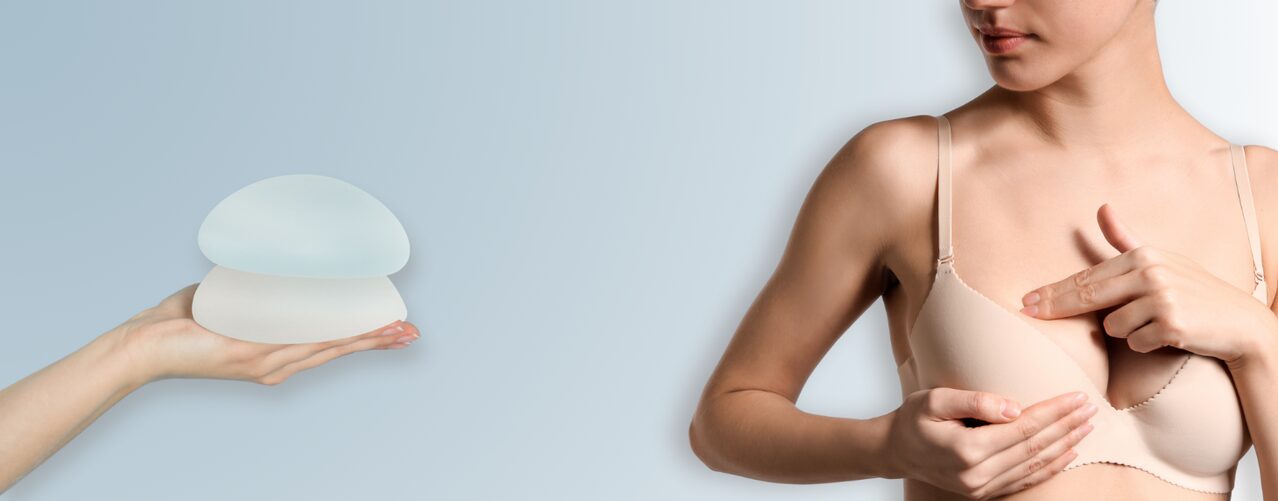Understanding Breast Implant Capsular Contracture
After breast augmentation surgery, it’s normal for your body to form a capsule around the implants composed of cell layers of vascularized connective tissue (Fibrous tissue), and the capsule can become problematic when thickened and constricted. The change in feel and look of your breast can be a confusing and frustrating experience.
Essentially all non-biologic material implanted in the body stimulates a response resulting in encapsulation (development of a capsule of fibrous material surrounding the implant). This effect of forming a capsule begins immediately after implantation. The capsule becomes a problem when it becomes tight, limits motion of the implant, adheres to surrounding muscle, rib, nerve, and soft tissue, or changes the shape and feel of the breast implant.
What Causes Capsular Contracture?
Capsular contraction has been reported in 2.3 % of patients with submuscular implants and 5x greater in subglandular implants. Some studies report 19% rate and the FDA quotes 28% risks over a lifetime.
There is “general agreement” that contracture is an inflammatory process. The precise cause remains debatable. There may be multiple factors that play a role such as:
- Biofilms
- Micromotion
- Silicone particles
- Chronic inflammation
- Preexisting autoimmune conditions
- Trauma (or microtrauma)
Biofilms (bacteria) stick to the Implant surface, and have been shown to stimulate an immune inflammatory response, and do not respond to antibiotic. As the body works to remove the bacteria, cells release compounds that further stimulate capsule formation.
Factors that may contribute to greater reduced risk of capsular contracture include use of inframammary crease incisions, gentle atraumatic dissection, careful hemostasis (low bleeding), use of implant sleeve, antimicrobial irrigation, and healthy patient with normal BMI. None of these factors eliminates the risk.
Treatment Options
The “standard” for treatment for capsular contracture includes capsulectomy, and replacement with new implants, or implant removal and capsulectomy alone. Other options include capsulotomy (making incisions in the capsule to release the tension), and implant removal alone. There are greater surgical risks with capsule removal vs incisions in the capsule to release the contraction. The recurrence rate however has been reported from 0 to 54% with both approaches. ADM (acellular dermal matrix) has been useful in some patients as a graft to reduce recurrent capsular contractures but does not eliminate risks and carries its own operative complications and significant increase cost.
Grades of Capsular Contracture (Baker Scale)
Grades of contracture are quite subjective. In general Baker Grade 3 and Grade 4 patients may have thicker capsules. However even Baker Grade 1 and 2 can have thick inflamed capsules potentially increase risk of implant seen during implant removal. Capsuled with intense inflammation can develop calcification that looks like “egg shells” . Studies conflict in supporting both saline and silicone gel as having the lowest contracture rate.
- Grade 1: The breast is typically soft and looks natural
- Grade 2: The breast is slightly firm, but looks normal
- Grade 3: The breast is firm and looks abnormal
- Grade 4: The breast is hard, painful and looks abnormal
The following patient pictures demonstrate before and after implant removal, and the right and left implants and right and left capsules removed.
Grade 1 Capsular Contracture Examples
The before and after photos below show examples of Baker Scale Grade 1 capsular contracture where the breast is typically soft and looks natural.
PATIENT #1: GRADE 1 CAPSULAR CLASSIFICATION
Capsules and symptoms will present differently in each patient. These photos represent the capsules removed from this particular patient.
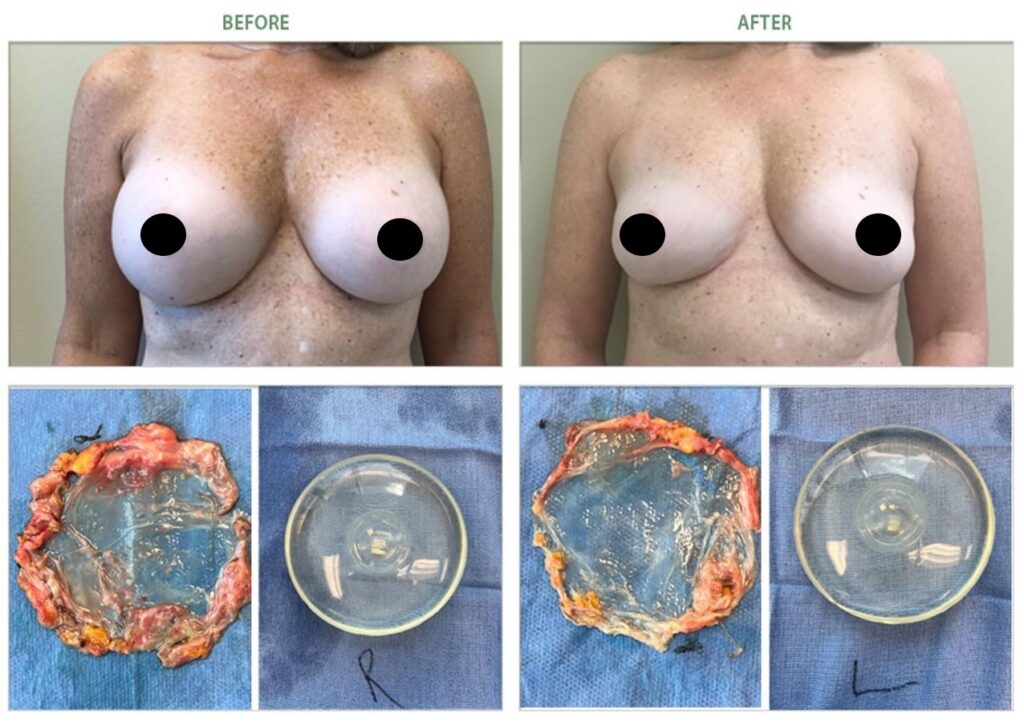
In these before and after photos you see the results of breast implant removal surgery with total capsulectomy through inframammary incisions on a 58-year-old woman who chose to have her 17-year-old saline implants explanted (removed).
Before Surgery:
- Patient experienced intermittent pain in the left breast and desired a more natural appearance and no longer wanted the size or feel of the implants.
- Soft breast tissue with minimal capsular contracture (Baker Grade 1)
- Implants: 300cc saline smooth
Surgical Procedure:
- Breast explantation with total capsulectomy (removal of implant and surrounding capsule) Inframammary incisions (incisions located in the crease beneath the breast)
After Surgery:
- Patient reports feeling great and has returned to normal activities without any pain.
PATIENT #2: GRADE 1 CAPSULAR CLASSIFICATION
Capsules and symptoms will present differently in each patient. These photos represent the capsules removed from this particular patient.
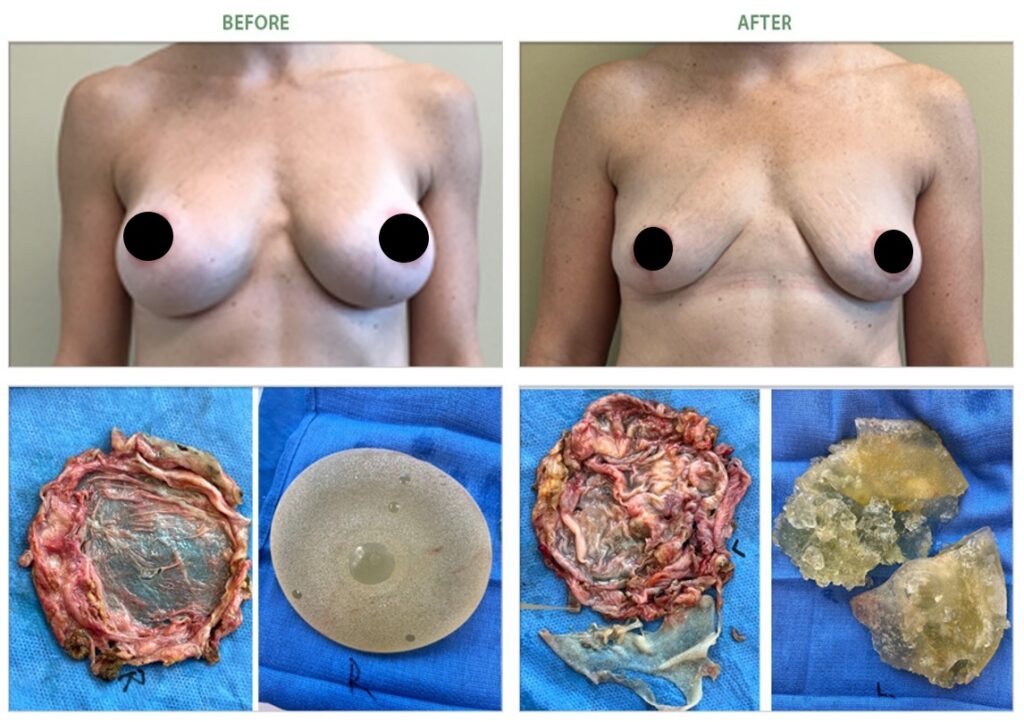
In these before and after photos you see the results of breast implant removal, capsulectomy and breast lift surgery on a 38-year-old woman with 13-year-old silicone gel implants explanted (removed) due to health concerns.
Before Surgery:
- Patient experienced left side of body numbness, stomach issues, bladder issues, cognitive issues, weight gain, hormones issues, headaches, migraines, neck and back pain. The patient stated this all started after getting implants
- Soft breast tissue with minimal capsular contracture (Baker Grade 1)
- Implants: 420cc silicone gel smooth
Surgical Procedure:
- Breast explantation, left implant ruptured, capsulectomy (removal of implant and surrounding capsule) and breast lift (mastopexy)
After Surgery:
- Patient reports significant resolution of symptoms following explant including joint pain, resolution of IBS, and resolution of documented neuropathy. Skin changes (acne) resolved and is now able to eat gluten for first time in 8 years, can drink coffee and alcohol, very little back pain now and feels joint pain is much better.
Grade 2 Capsular Contracture Examples
The before and after photos below show examples of Baker Scale Grade 2 capsular contracture where the breast is slightly firm, but looks normal.
PATIENT #3: GRADE 2 CAPSULAR CLASSIFICATION
Capsules and symptoms will present differently in each patient. These photos represent the capsules removed from this particular patient.
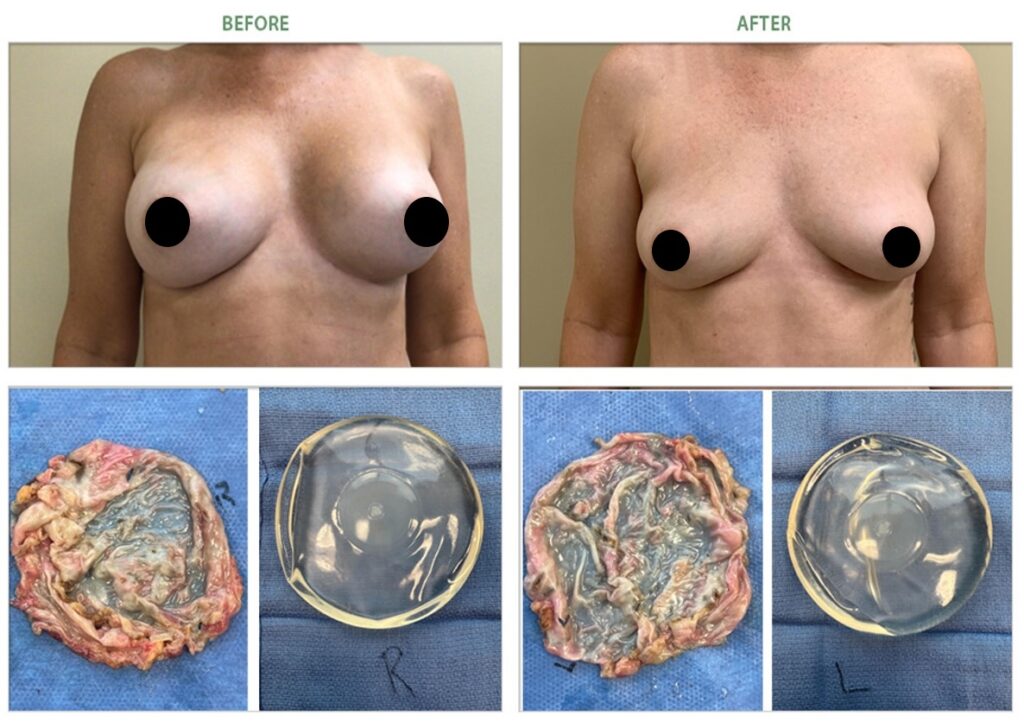
In these before and after photos you see the results of breast implant removal surgery and total capsulectomy on a 41-year-old woman with 5-year-old silicone gel implants explanted (removed) due to health concerns.
Before Surgery:
- Patient experienced started experiencing health issues within a year after surgery consistent with BII including joint pain, lethargic, and headaches within one year of breast augmentation surgery.
- Soft slightly firm breast tissue (Baker Grade 2)
- Implants: 700cc silicone gel
Surgical Procedure:
- Breast explantation, capsulectomy (removal of implant and surrounding capsule)
After Surgery:
- Patient reporting feeling so much better and has no joint paint, health concerns and fatigue dramatically improved since having implants removed.
PATIENT #4: GRADE 2 CAPSULAR CLASSIFICATION
Capsules and symptoms will present differently in each patient. These photos represent the capsules removed from this particular patient.
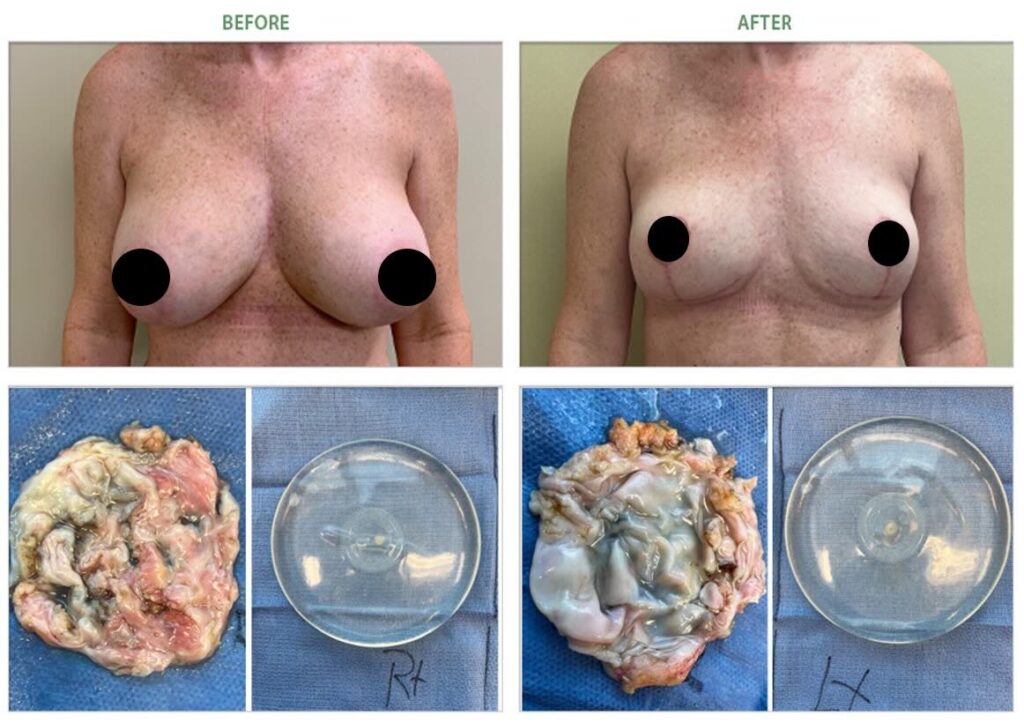
In these before and after photos you see the results of breast implant removal surgery, total capsulectomy and breast lift on a 46-year-old woman with 11-year-old saline implants explanted (removed) because the patient desired smaller more natural breasts.
Before Surgery:
- Patient desired smaller more natural breasts. No health concerns were reported before surgery.
- Slightly firm breast tissue (Baker Grade 2)
- Implants: 425cc saline smooth
Surgical Procedure:
- Breast explantation, capsulectomy (removal of implant and surrounding capsule) and breast lift (mastopexy)
After Surgery:
- Patient reported that she noticed significant resolution in GI bloating after explant surgery
Grade 3 Capsular Contracture Examples
The before and after photos below show examples of Baker Scale Grade 3 capsular contracture where the breast is breast is firm and looks abnormal.
PATIENT #5: GRADE 3 CAPSULAR CLASSIFICATION
Capsules and symptoms will present differently in each patient. These photos represent the capsules removed from this particular patient.
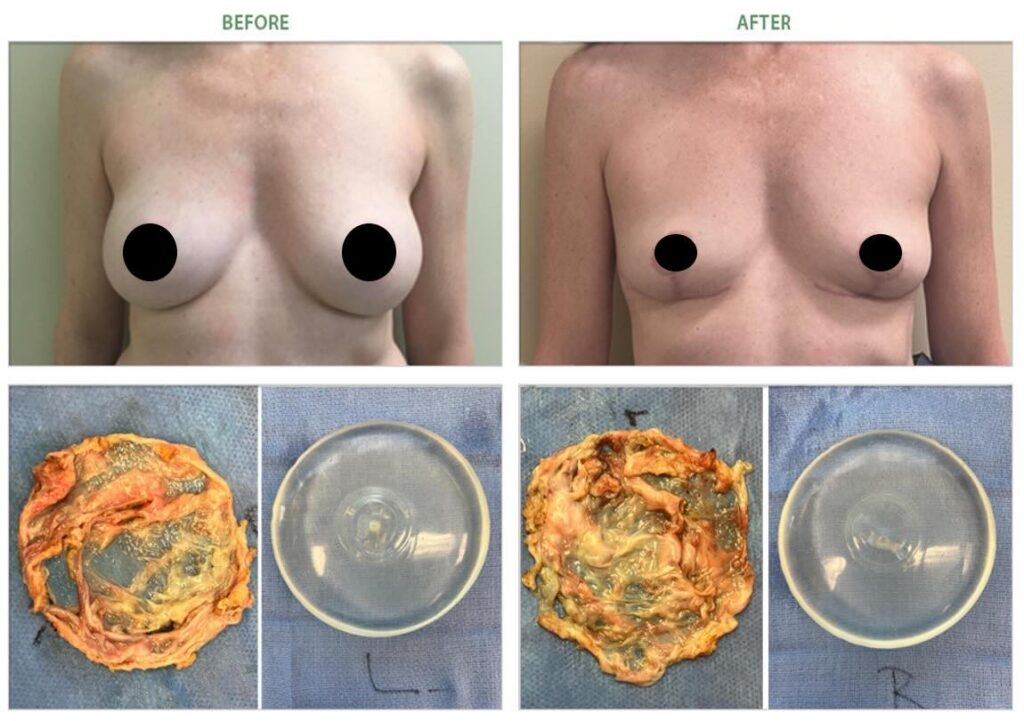
In these before and after photos you see the results of breast implant removal surgery, capsulectomy and breast lift on a 46-year-old woman with 22-year-old saline implants explanted (removed) due to health concerns.
Before Surgery:
- Patient was experienced pain in right breast, brain fog, neck pain, chest tightness
- firm breast tissue with assymmetry (Baker Grade 3)
- Implants: 300cc saline smooth
Surgical Procedure:
- Breast explantation, capsulectomy (removal of implant and surrounding capsule) and breast lift (mastopexy)
After Surgery:
- Patient reported resolution of symptoms including cognitive issues (brain fog), return to normal range of motion, resolution of breathing complaints.
PATIENT #6: GRADE 3 CAPSULAR CLASSIFICATION
Capsules and symptoms will present differently in each patient. These photos represent the capsules removed from this particular patient.
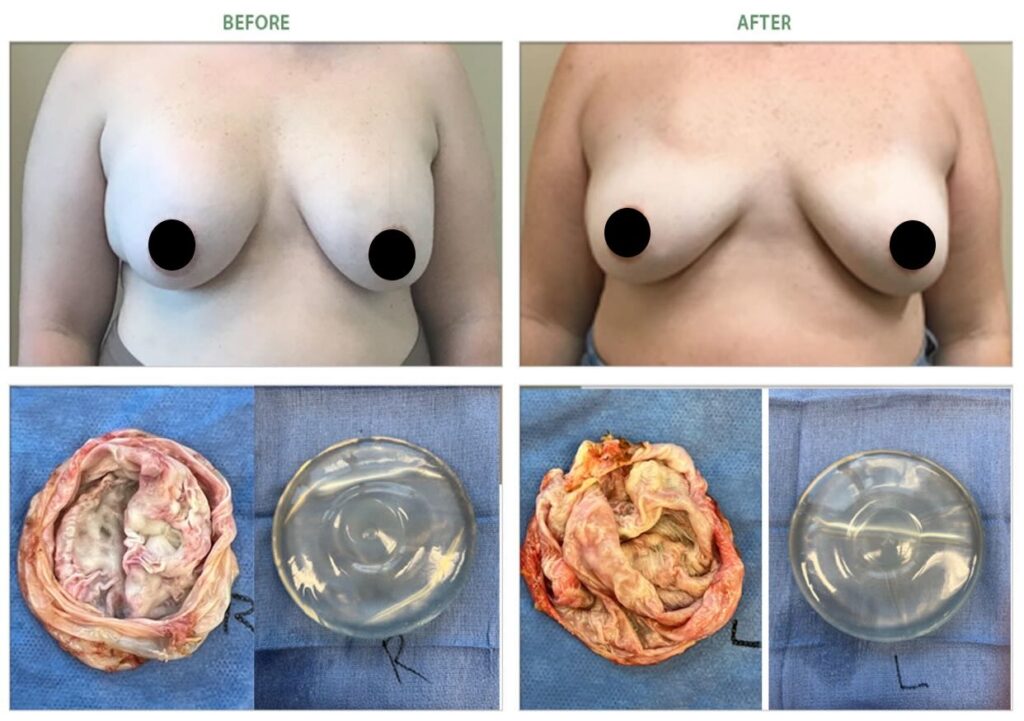
In these before and after photos you see the results of breast implant removal surgery and total capsulectomy on a 29-year-old woman with 5-year-old silicone gel implants explanted (removed) due to health concerns.
Before Surgery:
- Patient was experiencing symptoms, pain in right breast, firmness and feels implants may be impacting her health
- Firm breast tissue, right with asymmetry (Baker Grade 3)
- Implants: 405cc saline smooth
Surgical Procedure:
- Breast explantation, capsulectomy (removal of implant and surrounding capsule)
After Surgery:
- Patient reported she is amazed at how much things have changed for the better. Her general health surprisingly improved with explant surgery.
Grade 4 Capsular Contracture Examples
The before and after photos below show examples of Baker Scale Grade 4 capsular contracture where the breast is breast is is hard, painful and looks abnormal.
PATIENT #7: GRADE 4 CAPSULAR CLASSIFICATION
Capsules and symptoms will present differently in each patient. These photos represent the capsules removed from this particular patient.
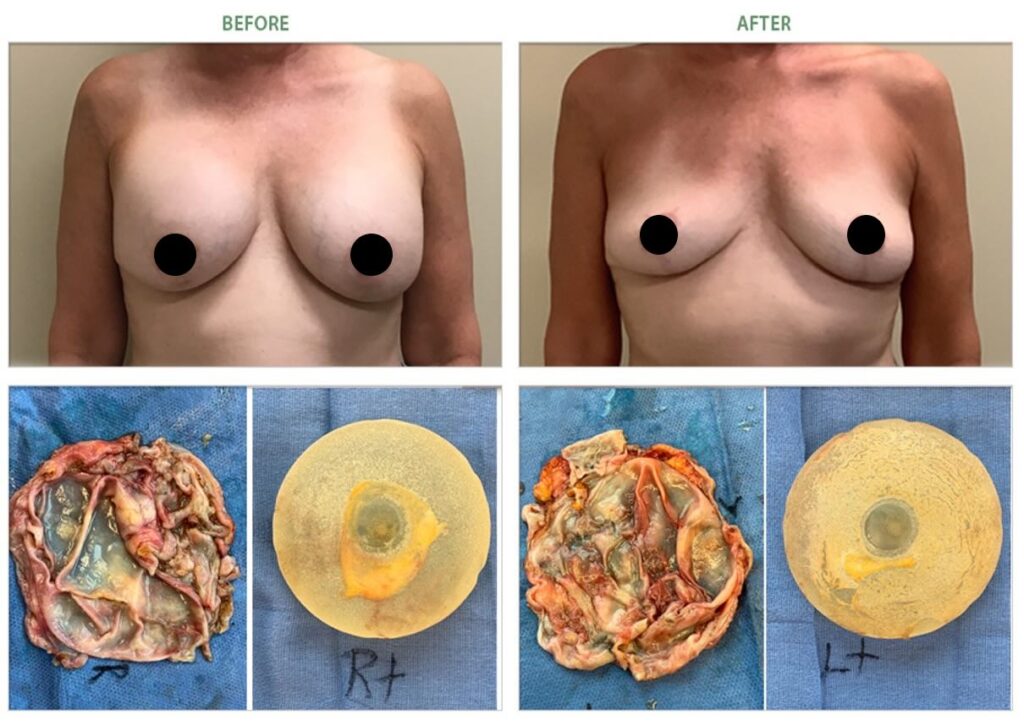
In these before and after photos you see the results of breast implant removal surgery, total capsulectomy and breast lift on a 60-year-old woman with 23-year-old saline implants explanted (removed) due to discomfort.
Before Surgery:
- Patient breast was hard and felt discomfort
- Hard breast (Baker Grade 4)
- Implants: Saline textured
Surgical Procedure:
- Breast explantation, capsulectomy (removal of implant and surrounding capsule) and breast lift (mastopexy)
PATIENT #8: GRADE 4 CAPSULAR CLASSIFICATION
Capsules and symptoms will present differently in each patient. These photos represent the capsules removed from this particular patient.
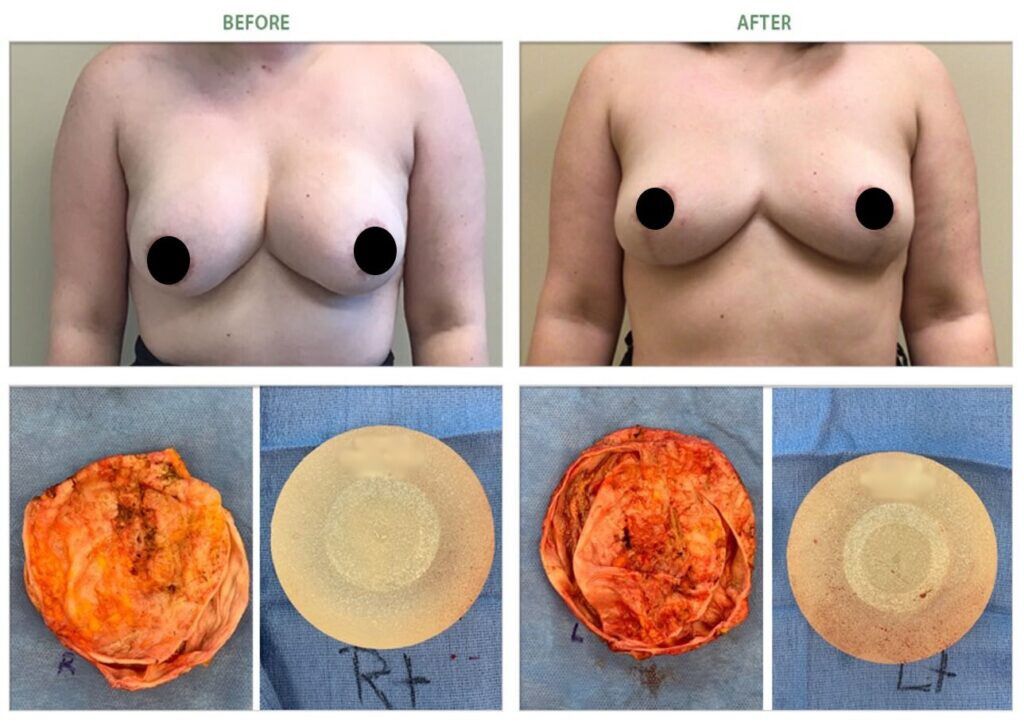
In these before and after photos you see the results of breast implant removal surgery, total capsulectomy and breast lift on a 31-year-old woman with 8-year-old saline implants explanted (removed) due to health concerns.
Before Surgery:
- Patient experienced hair loss, low libido, fatigue, thyroid issues, GI issues, rashes. She has been diagnosed with Hashimoto’s and IBS.
- Firm breast tissue with asymmetry, prior breast lift, left breast nipple displaced laterally (Baker Grade 4)
- Implants: 380cc saline smooth
Surgical Procedure:
- Breast explantation, capsulectomy (removal of implant and surrounding capsule) and breast lift (mastopexy)
PATIENT #9: GRADE 4 CAPSULAR CLASSIFICATION
Capsules and symptoms will present differently in each patient. These photos represent the capsules removed from this particular patient.
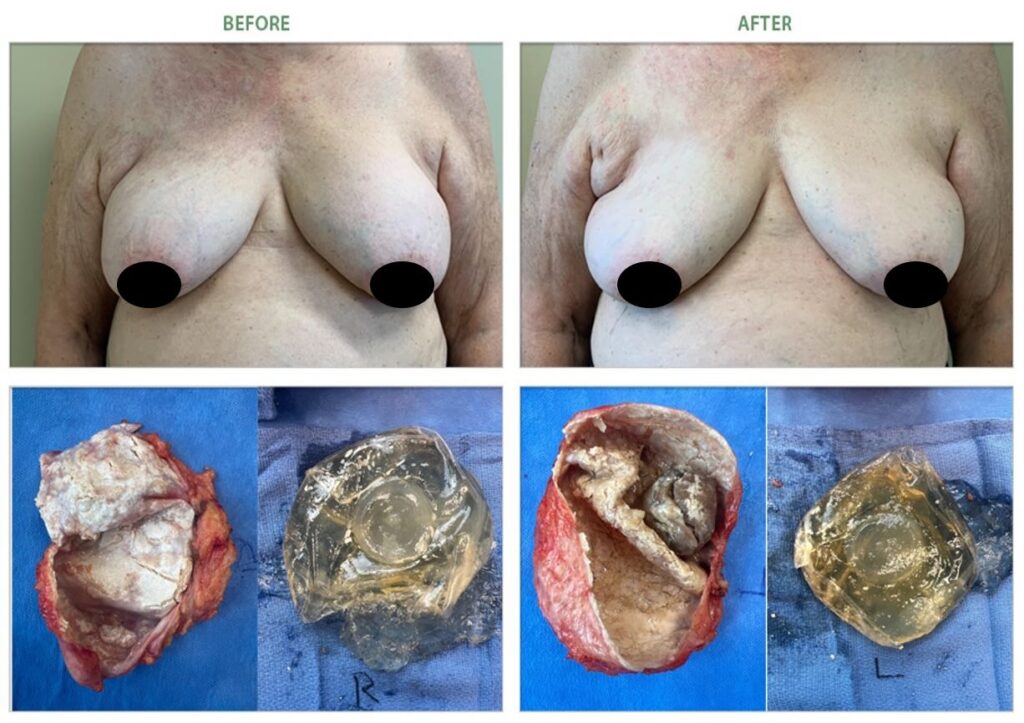
In these before and after photos you see the results of breast implant removal surgery with total capsulectomy on a female patient with concerns about old and possible ruptured implants.
Before Surgery:
- Patient experienced hard and firm breasts
- Hard breasts (Baker Grade 4)
- Implants: Silicone gel smooth
Surgical Procedure:
- Breast explantation with total capsulectomy (removal of implant and surrounding capsule)
Breast Implant Capsule Frequently Asked Questions
Breast implant capsular contracture can be a confusing and concerning complication. While the images you’ve seen might raise questions, this FAQ section here to help. We’ll answer common concerns and help keep you informed you about capsular contracture, its symptoms, and treatment options.
Do all breast implants develop a capsule?
Yes. All implants are foreign to the body (not biologic) and the body responds by making a capsule to surround the implant.
What is a breast capsule?
A capsule is layers of cells and fibers that surround the implant. This tissue also has a blood supply.
When are capsules a problem?
Breast implant capsules become problematic if they become tight around the implant. This is called a capsular contracture.
What happens if a capsule tightens?
A tight capsule can change the shape of the implant, resulting in a visible change in your appearance.
How do tight capsules feel?
A tight capsule and make an implant feel hard. As tightening occure, the capsule can pull against other normal tissue including muscle, ribs, and nerves and cause pain, restrict motion, and be uncomfortable with daily activities.
What is a tight capsule called?
Capsular Contraction is the term used for tight capsules.
Can you look at a capsule and tell if it is causing a contracture?
In surgery, capsules can be thin or thickened and both cause tightening and distortion of the implant. However thicker capsules are more likely to be associated with a contracture.
Can you look at a capsule and tell if there is inflammation involved?
All capsuled are result of inflammatory process. Thicker irregular capsules are typically more inflamed. Capsules that have calcified (developed areas of material that resembles broken egg shells) are associated with greater inflammation and cellular damage.
Is the appearance of the capsule related to symptoms that patients report in breast implant illness concerns?
Not necessarily. Patients may have symptoms from fatigue to skin changes that resolve with removal of implants and very thin capsules. Patients may have thick capsules that look very inflamed that are found incidentally with implant removal for other reasons, ar exchange.
Do ruptured implants contribute to thicker capsules?
Often ruptured gel implants are associated with thicker more inflamed capsules. Some of these changes may take years to develop.
Can saline ruptures effect capsules?
Very often, patients who have a deflated saline implant will experience tightening of the capsule with loss of volume and local changes following saline absorption.
How are capsules classified (graded)?
A grading system is somewhat subjective. The standard is called the Baker Grading system.
How common is capsular contraction?
Long term studies vary widely and report problematic capsular contracture rates as low as 2.5% to 19%. The FDA reports rates up to 28% of patients over the lifetime of the implant.
Can capsular contractures be prevented?
Studies have linked biofilms (bacteria that stick to the implant surface), operative technique, careful control of bleeding during augmentation, incisions used to place implants, implant pocket position (below the muscle less contracture than above), and prior history of auto immune disease in the patient with greater risk of capsular contracture. There is no known way to eliminate the risk.
What is the treatment for capsules that contract and cause problems?
The “standard” for treatment includes capsulectomy (surgical removal of the capsule), and replacement with new implants. There are greater surgical risks with capsule removal vs incisions in the capsule to release the contraction (called a capsulotomy).
If you have developed a capsular contracture, and have implants replaced, what is the risk of another contracture forming?
Most studied show a greater risk of another capsule contracture, even if it took years for the first one to develop. But studies report risk near 0% to 54% of patients developing another capsular contracture.
If the implants and capsules are surgically removed, will capsules reform?
With normal healing, capsules will not develop after the implant is removed.
What is the most common reported complication of breast augmentation?
The most common complication reported with breast augmentation is capsular contraction.
We Understand Your Concerns
Capsular contracture can be physically and emotionally challenging. If you’re facing this, know that you’re not alone. There are resources and support available.
Next Steps:
- Speak to a board-certified plastic surgeon with experience in breast implant illness and removal about your concerns.
- This FAQ section can answer common questions about capsular contracture.
- Consider joining a support group for women who have experienced breast implant complications.
Remember: Early diagnosis and treatment can improve your outcome.
References
Unveiling the Enigma: Exploring capsular contracture–Unraveling its link with autoimmune disorders and comprehensive examination of predisposing factors
Bikona Ghosh,a,⁎ Alsalt AL-Busaidi,b Mehul Sinha,c Yeisson Rivero-Moreno,d Jose Carlos Del Castillo Miranda,e Darren Gopaul,f and Sarosh Sarwarg
2024 Jun; 40: 85–94.
Published online 2024 Feb 2. doi: 10.1016/j.jpra.2024.01.015 JPRAS Open.
Current Concepts in Capsular Contracture: Pathophysiology, Prevention, and Management
Tyler Safran 1, Hillary Nepon 2, Carrie K Chu 3, Sebastian Winocour 4, Amanda M Murphy 1, Peter G Davison 1, Tassos Dionisopolos 1, Joshua Vorstenbosch 1
Semin Plast Surg2021 Aug;35(3):189-197.
Acellular dermal matrix in breast augmentation surgery: A systematic review
Caterina Marraa , Roberto Cuomo b,∗ , Alessandra Ceccaroni a , Paola Pentangeloa , Carmine Alfano. JPRASVOLUME 40, P111-117, JUNE 2024

